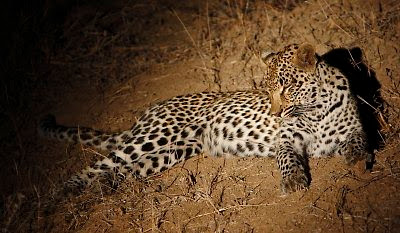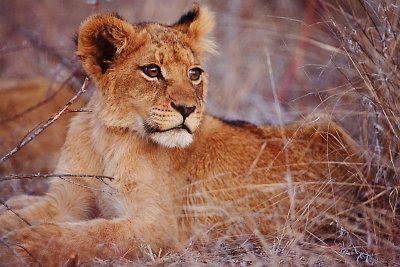Andrew was the only Motswari guide out on drive on Monday morning, and he had a quiet drive on the big 5 front, only ticking of a breeding herd of elephant and two buffalo bulls.
We were full camp in the afternoon and went out with four vehicles, I returned to drive, and it was a nice start. There was a breeding herd of elephant found just to the north of camp that Herald and Elliot went to have a look at, but I decided to try for some of the elephants that were being reported in the south, as there was another sighting west of Hide dam that I was keen to go and see. There was some nice general game in the form of wallowing warthogs, feeding warthogs, impala, kudu, giraffe, steenbok and duiker. I only managed to find a few scattered elephants around Confluence crossing, but not the bulk of the breeding herd, so I went and spent time with three young male elephants that browsed non-chalantly a few meters from the Land Rover. While watching them a large Verraux Eagle Owl perched itself on a nearby dead tree, and with the dusky sky in the background made for a nice scene. Elliot saw another small herd of elephant and two buffalo bulls west of Peru dam.
Andrew headed straight south and got rewarded with two leopard sightings. Firstly, after watching a hyena cooling off in the water at Hide dam, he went around to the drainage line behind the dam to have a look at Rockfig female leopard who had been found resting in a small Jackalberry tree. From all accounts her ear is not getting any better, and if anything, it is looking even worse than when she was seen last week. His second leopard sighting was the reason that I too headed down south, and that was to see Rockfig’s daughter, Nkateko female leopard, who had been found with a duiker kill stashed up high in a knobthorn tree a bit further west from where her mother was (and interestingly, Rockfig’s other daughter, Rockfig Jnr, had been seen in the area in the morning, far north from where she normally hangs out!).
I headed to the sighting after dark, and found Nkateko resting at the top of the tree, but she soon woke up and decided to climb down the tree. She was not in a mood to play along with us and kept walking in circles! I would no sooner position myself next to where she was lying down before she would get up again, then I would try once more and she would move again. Third time lucky I though, but then she suddenly jumped back up and ran off to the tree where her kill was! The reason soon became apparent when one of the young clan members from the resident Rockfig hyena clan showed up and chased Nkateko back up the tree! Nkateko went to sleep in the safety of the high branches, while the young hyena scavenged for scraps at the bottom of the tree, only finding a small piece if meat that she ate in front of us before moving off to lie down herself. We left these two adversaries in their same positions and headed back to camp.
Tuesday morning saw Andrew heading to the south again to have another look at Nkateko female leopard, and she was still in the same tree resting next to her kill. On the way south Andrew saw two different breeding herds of elephant in the southern half of the reserve. Herald checked the central regions and saw two buffalo bulls, and a breeding herd of elephant near Leopard Rock hide.
Elliot went to see if there was any sign of the Sohebele pride of lions in the north eastern corner of our traversing, and found tracks from yesterday. He carried on checking and soon found tracks on our north eastern boundary, but the tracks crossed off the property, and headed north-east, deep into the Umbabat, an area of the reserve that I personally have never seen the Sohebele lions wander into. I had moved into the area to try and assist Elliot, but upon hearing that the tracks had moved off into the Umbabat, I went to check our eastern section along the Kruger National Park boundary. It was a decided quiet morning in the north, and besides some kudu, impala, steenbok and a sighting of a lone bull elephant feeding near Argyle dam, I didn’t have a very productive morning up until coffee time.
While having coffee two of the world’s largest flying land birds, the Kori Bustard, came to have a drink at Karan’s Big Dam. It was the first time I had seen these birds drink, so that was quite a treat. We also saw some more impala and a small group of zebra, and as we arrived back at camp, a female giraffe and a calf came walking past the reception and we followed them as they were heading towards Trade Entrance dam to have a drink. It took some time, but we sat patiently as the mother giraffe cautiously surveyed the area before deciding that it was safe to drink, and went into the awkward pose that giraffes have to enter in order to drink. You could see she had done it thousands of times before, but the 6-month old calf was not nearly as steady, and his poor little legs shook as he drank with a bit more difficulty. It was a really enjoyable sighting, and was a good way to end the morning’s drive.
The biggest problem was that there was no sign of lions in the north, and I couldn’t guarantee that either the Mahlathini male lions or the Sohebele pride would return before my guests checked out the next morning. So we made a plan, and as is the great thing in the Timbavati, we have great relations with all of our neighbouring lodges, so we got permission to go far south, further south than we normally traverse, in order to go and see the Machaton pride of lions. It was a long trip, but our guides were more than happy to make it in order to show our guests some lions (in any case, we always enjoy driving in areas that we don’t often get to visit!)
Andrew stayed in the relative north as he had new guests, so he and Elliot went to go and see Nkateko female leopard who was still in the same place as the last couple of drives with her duiker kill, and still had a fair share of meat left on it. Elliot, Herald and I went south. It was a hot afternoon, the mercury still showing 36 degrees Celsius in the shade at 16h00, and the animals were still sticking to shade until the evening started to cool off. There were the usual impala and kudu about, and we got to see an extraordinarily large group of 27 male buffalos drinking at Nkombi pan on the way south. There was also a lone female giraffe feeding along the main road, and further to the north, Herald had seen a breeding herd of elephant.
I eventually cut back into the reserve and found a small herd of elephant drinking and swimming at Eileen’s dam. The two calves really seemed to relish the chance to splash in the water, while the adults drank, but they soon moved off and we left them dusting bathing behind the dam wall. Herald and Elliot were just leaving the lions when I arrived, and first I went to see the one Machaton lioness and her two six-month old cubs. The two youngsters were a bit sleeping, but soon roused and started chewing on a stick, something young cubs seem to do quite often! They half-hearted stalked after two francolins that approached, but the birds flew away with a flutter when one of the cubs stood up. The three Timbavati male lions were just 100m away, but when I went to see them, I just couldn’t find them. I drove down a treacherous river crossing to see if they had perhaps gone down to the river, but all I found was an elephant bull in musthe! He had been following another breeding herd of elephant that I had bypassed on my way to the lions. The Timbavati males were not there, so I struggled up the river crossing again, using all of my poor Land Rovers ability to get us out, and just as I was driving away from the area, I was radioed and told that the males had arrived to join the lioness and cubs. I returned to show my guests the male lions, and also got to watch the two cubs suckling milk from mom. The male lion was busy sniffing around and pulling an impressive flehmen grimace, showing his impressie canines. He then wandered over to the suckling cubs, the one cub made a playful swipe at his face, but he seemed very tolerant of his daughter, and simply flopped down fast asleep next to the lioness, and that was our cue to head back to camp!
On the way home, we had a great sighting of a Spotted Eagle Owl sitting on a branch next to the road, I got to within 4m of the owl, and it didn’t seem fussed by our presence at all. It just sat there looking around for some potential insect meals, and we left him in peace.
And that was the last two days in the Timbavati. It was nice to go south again, but I just hope that our lions return to the north again soon!






























No comments:
Post a Comment